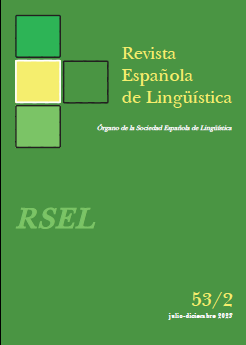Linguistic variation or the emergence of new High varieties of the Arabic language: Morocco as a case study
doi: https://doi.org/10.31810/rsel.53.2.6
Keywords:
Linguistic continuum; Linguistic variation; MoroccoAbstract
Monograph introduction.
Downloads
References
Abdel Jawad, H. R. (1986). The emergence of an urban dialect in the Jordanian urban centres, International Journal of the Sociology of Language 61, 53-63. doi: https://doi.org/10.1515/ijsl.1986.61.53
Achour, M. (2022). La diglossie traversée: La littérature en tunisien et le tunisien dans la littérature, International Journal of the Sociology of Language 278, 23-50. doi: https://doi.org/10.1515/ijsl-2022-0018
Badawi, E. A. (1973). Mustawayāt al-lugha al-‘arabiyya al-mu‘asira fi miṣr [Levels of Contemporary Arabic in Egypt]. Cairo: Dar al-Ma’arif.
Bassiouney, R. (2010). Identity and code-choice in the speech of educated women and men in Egypt: Evidence from talk shows. En R. Bassiouney (Ed.), Arabic and the Media, pp. 97-121. Londres: Brill. doi: https://doi.org/10.1163/ej.9789004182585.i-303.50
Brustad, K. (2017). Diglossia as Ideology. En J. Høigilt y G. Mejdell (Eds.), The Politics of Written Language in the Arab World. Writing Change, pp. 41-67. Leiden: Brill. doi: https://doi.org/10.1163/9789004346178_004
Caubet, D. (2017). Morocco: An Informal Passage to Literacy in dārija (Moroccan Arabic). En J. Høigilt y G. Mejdell (Eds.), The Politics of Written Language in the Arab World. Writing Change, pp.116-141. Leiden: Brill. doi: https://doi.org/10.1163/9789004346178_007
Corriente, F. (1971). On the functional yield of some synthetic devices in Arabic and Semitic morphology, Jewish Quarterly Review 62, 20-50. doi: https://doi.org/10.2307/1453861
Ferguson, Ch. A. (1959). Diglossia, Word 15: 2, 325-340. doi: https://doi.org/10.1080/00437956.1959.11659702
Ferguson, Ch. A. (1996). Epilogue: Diglossia revisited. En A. Elgibali (Dir.) Understanding Arabic: Essays in Contemporary Arabic Linguistics in Honor of El-Said Badawi, pp. 49-67. Cairo: American University of Cairo Press.
Ferrando I. (2012). El árabe marroquí en la novela del siglo XXI. El caso de Salem Himmich y su obra فتنة الرؤوس والنسوة . En A. Barontini, Ch. Pereira, Á. Vicente y K. Ziamari (Eds.), Dynamiques langagières en Arabophonies: variations, contacts, migrations et créations artistiques. Hommage offert à Dominique Caubet par ses élèves et collègues, pp. 415-426. Zaragoza: Área de Estudios Árabes, Universidad de Zaragoza.
Fishman, J. A. (1967). Bilingualism With and Without Diglossia; Diglossia With and Without Bilingualism, Journal of Social Issues 23: 2, 29-38. doi: https://doi.org/10.1111/j.1540-4560.1967.tb00573.x
Gallego, M. Á. (2010). The Impact of Arabic Diglossia among the Muslims, Jews and Christians of al-Andalus. En F. Cabo Aseguinolaza, A. Abuín González y C. Domínguez (Eds.), A Comparative History of Literatures in the Iberian Peninsula 1, pp. 351-365. Ámsterdam: John Benjamins. https://doi.org/10.1075/chlel.xxiv.17ang
Hachimi, A. (2013). The Maghreb-Mashreq language ideology and the politics of identity in a globalized Arab world, Journal of Sociolinguistics 17: 3, 269-296. doi: https://doi.org/10.1111/josl.12037
Haeri, N. (2003). Sacred language, ordinary people: Dilemmas of culture and politics in Egypt. Nueva York: Palgrave Macmillan.
Hary, B. (1996). The importance of the language continuum in Arabic multiglossia, en A. Elgibali (Ed.), Understanding Arabic: Essays in contemporary Arabic linguistics in honor of El-Said Badawi, pp. 69-90. Cairo: American University of Cairo Press.
Marçais, W. (1930). La diglossie arabe, L’Enseignement Public – Revue pédagogique 104: 12, 401-409.
Mejdell, G. (2011-2012). Diglossia, Code Switching, Style Variation, and Congruence: Notions for Analyzing Mixed Arabic, Al-‘Arabiyya 44-45, 29-39.
doi: https://www.jstor.org/stable/43208722
Miller C. (2013). Évolution des usages linguistiques dans les nouvelles radios marocaines. En M. Benítez Fernández, C. Miller, J. J. de Ruiter y Y. Tamer (Eds.), Évolution des pratiques et des représentations linguistiques dans le Maroc du XXIème siècle, pp.14-59. París: L’Harmattan.
Mitchell, T. F. (1986). What Is Educated Spoken Arabic?, International Journal of the Sociology of Language 61: 1, 7-32. doi: https://doi.org/10.1515/ijsl.1986.61.7
Moscoso García, F. (2010). La pentaglosia en Marruecos. Propuesta para la estandarización del árabe marroquí, Miscelánea de estudios árabes y hebraicos. Sección árabe e islam 59, 45-61.
Pellat, Ch. (2023). Laḥn al-ʿĀmma. En P. Bearman, Th. Bianquis, C.E. Bosworth y E. van Donzel (Eds.), Encyclopaedia of Islam, Second Edition. Consultado online el 10 de Agosto. doi: http://dx.doi.org/10.1163/1573-3912_islam_SIM_4613
Psichari, J. (1885). Essais de grammaire historique néo-grecque, Annuaire de l’Association pour l’Encouragement des Études Grecques en France 19, 1-228.
Ruiz Girela, F. (Ed. y trad.) (2008). Ibn Jaldun, A. Introducción a la historia universal (al-Muqaddima). Córdoba: Al-Muzara.
Sayahi, L. (2014). Diglossia and Language Contact: Language Variation and Change in North Africa. Cambridge: Cambridge University Press.
Versteegh, K. (1997). The Arabic linguistic tradition. Landmarks in linguistic thought III. Londres: Routledge.
Versteegh, K. (2001). The Arabic language. Edimburgo: Edinburgh University Press.
Youssi, A. (1983). La triglossie dans la typologie linguistique, La Linguistique 19: 2, 71-83.
Youssi, A. (1992). Grammaire et lexique de l’arabe marocain modern. Casablanca: Wallada.
Published
How to Cite
Issue
Section
Copyright (c) 2023 Revista Española de Lingüística

This work is licensed under a Creative Commons Attribution-NonCommercial-NoDerivatives 4.0 International License.











